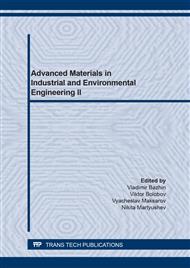p.101
p.109
p.117
p.124
p.132
p.139
p.153
p.159
p.165
Properties of Microfibers of Various Compositions as a Component of Cellular Composites
Abstract:
The paper presents studies on the properties of various types of micro-reinforcing fibers to assess their role and effectiveness in the structure formation of the cellular composite. Based on the data on the weight loss after exposure in a model medium of cement, analysis of the alkali resistance of fibers of five different types – basalt fiber, heat-treated basalt fiber, polymer fiber and glass fibers from two different manufacturers – was carried out. It is shown that the fibers have a sufficiently high durability in the medium of hardening cement, which is expressed by a relatively insignificant weight loss of the original fiber after exposure in a model medium for 28 days in ambient conditions. The weight loss for some fibers sharply increases when hardening conditions are changed to hydrothermal ones. The images of fibers exposed in a model medium of cement, obtained using scanning microscopy, were also analyzed, and the character of distribution of acidic and basic adsorption sites on the surface of fibers depending on the type was assessed. Based on the analysis of the obtained data, we can talk about a high number of active sites on the surface of basalt and glass fibers, which ensures the formation of crystalline new formations on them and makes it possible to predict their high adhesion to the cement matrix.
Info:
Periodical:
Pages:
132-138
Citation:
Online since:
July 2021
Keywords:
Price:
Сopyright:
© 2021 Trans Tech Publications Ltd. All Rights Reserved
Share:
Citation:


